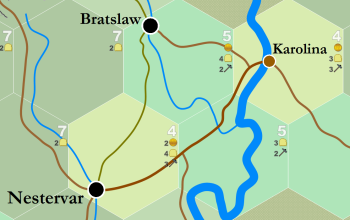Difference between revisions of "Coin (symbol)"
Tao alexis (talk | contribs) (→Wealth) |
Tao alexis (talk | contribs) (→Wealth) |
||
| Line 44: | Line 44: | ||
|- | |- | ||
| 1 || [[Debt|debt]], [[Ownership|ownership]], [[Taxation|taxation]] || [[Elder Authority|elder authority]], [[Land as Security|land as security]] || [[Loan Interest|loan interest]], [[Rent|rent]], [[Squire|squire]] || [[Contracts|contracts]], [[Letter of Credit|letter of credit]] | | 1 || [[Debt|debt]], [[Ownership|ownership]], [[Taxation|taxation]] || [[Elder Authority|elder authority]], [[Land as Security|land as security]] || [[Loan Interest|loan interest]], [[Rent|rent]], [[Squire|squire]] || [[Contracts|contracts]], [[Letter of Credit|letter of credit]] | ||
| + | |- | ||
| + | | 2 || rowspan="6"|1 coin maximum || [[Bailment|bailment]], [[Heredity|heredity]] || [[Baronetcy|baronetcy]], [[Debt Slavery|debt slavery]], [[Road Toll|tolls]] || [[Burgher (social class)|bourgeoisie]], [[Day Market|day market]], [[Property Tax|property taxes]], [[Serfdom|serfdom]] || [[Auctioning|auctioning]], [[Personal Loans|loans]], [[Property Seizure|seizure]], [[Tutoring|tutoring]] | ||
|} | |} | ||
Revision as of 17:57, 8 December 2022
-
 6-mile map of the settlements Nestervar and Bratslaw, and the village of Karolina, showing one or more coins in both type-4 and type-5 hexes.
6-mile map of the settlements Nestervar and Bratslaw, and the village of Karolina, showing one or more coins in both type-4 and type-5 hexes.
Coins are symbols used on game maps to represent the presence of commercial, financial and fiscal activity that occurs within a given civilised hex. The number of coins possessed by a hex is determined by the hex type, which in turn is a product of infrastructure. Hex types range from 1 to 8, with a "1" indicating a highly civilised hex and an "8" indicating uncivilised wilderness. Thus, type-1 and type-2 hexes possess many coins, while type-7 and type-8 hexes may have none at all.
| Hex Type % |
Coins Gained | ||
|---|---|---|---|
| Cultivated | Mined | Oasis | |
| 8 or 7 | 0 | 0 | 0 |
| 6 | 0 | 1 | 0 |
| 5 | 0 | 1 | 0 |
| 4 | 1 | - | 2 |
| 3 | 2 | - | 3 |
| 2 | 3 | - | 4 |
| 1 | 5 | - | 6 |
Coin Location
Maps in which coins appear come from hexes with three designations: "cultivated," "mined" and "oasis." Cultivated hexes are primarily farm and pasture land, from which grow villages, towns and cities. Mined hexes exploit isolated areas for their mineral wealth. Type-5 to type-7 hexes that occur in mountains and other rocky places that are plainly non-arable are designated as mined. Any type of hex from 1 to 7, that appears in a well-watered valleys, hills or plains, is considered cultivated, with the exception of oasis. Oasis hexes can only occur in specific desert places where one or more isolated water sources are surrounded by desert.
In addition to the coins added by type, an additional +1 coin is awarded if the hex is located on a body of water that's at least four square miles in area, AND if the hex is a type 1 to 6 hex. The amount of land on the hex must also equal at least 4 square miles. Thus, lakeshores and coastal hexes collect more coins, thus having more active economies than inland hexes. Water-borne trade brings many more customers and is much more interesting as a place to invest.
A +1 coin is also given for each settlement a hex includes. This means a cultivated type-7 hex might have one coin gained from a settlement, but cannot gain a coin from it's location on water. A cultivated type-6 hex on a sea or lake, and with a settlement in it, might have 2 coins, neither of which was gained from its type.
Wealth
The presence of coins don't describe quantity of wealth as much as they describe the activity of wealth. Money is measured by the "velocity" with which it's exchanged ... the more coins symbolised in a given hex, the more rapidly a single gold, silver or copper coin moves from person to person. A single coin demonstrates a very low rate of exchange ... and consequently, opportunities for profit-making, trade and investment are non-existent. The table below seeks to explain how much financial or commercial activity, and what kind, can be expected to take place in a hex as dictated by the number of coin symbols it has.
| # Coins | When Occurring in this Type | ||||||
|---|---|---|---|---|---|---|---|
| Type-7 | Type-6 | Type-5 | Type-4 | Type-3 | Type-2 | Type-1 | |
| 0 | bartering, notes | 1 coin minimum | 2 coins minimum | 3 coins minimum | 5 coins minimum | ||
| 1 | debt, ownership, taxation | elder authority, land as security | loan interest, rent, squire | contracts, letter of credit | |||
| 2 | 1 coin maximum | bailment, heredity | baronetcy, debt slavery, tolls | bourgeoisie, day market, property taxes, serfdom | auctioning, loans, seizure, tutoring | ||
